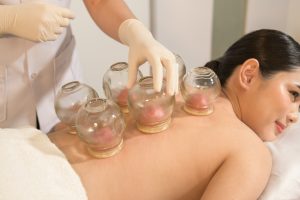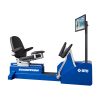
Cupping Therapy: Do Your Patients Really Need It?
Treatment GuidelinesCupping therapy is a trendy treatment method. Various sports medicine professionals and athletes have touted it as a cure-all modality. What does the evidence say?
Over the past few decades, we’ve rebranded several treatments that were once considered part of Traditional Chinese Medicine (TCM) into something more appealing to modern patients. For instance, dry needling is a popular new treatment modality, which bears striking similarity to the practice of acupuncture.
Cupping therapy serves as another example of TCM techniques being rebranded and slightly modified to be more palatable for patients in the current era.
But while we could quibble about the similarities and differences between modern techniques that appear similar to TCM techniques, a more useful question is: “do these treatments work?”
Specifically, for the purposes of this article, we will examine whether cupping therapy is a technique which you should consider adding to your practice, or whether it’s one you should avoid.
Cupping 101
Cupping therapy falls under the umbrella of Traditional Chinese Medicine. Generally, treatments that are part of the TCM toolbox were developed thousands of years ago, with modifications and refinements taking place over time1.
There is some disagreement amongst scholars as to exactly when and where cupping therapy was first used. However, the consensus is that both ancient Chinese and ancient Egyptian cultures (at a minimum) used cupping therapy as a regular part of their medicinal practices.2
Early on, cupping therapy (along with other TCM practices) focused on opening “meridians” of the body. It was thought that this could eliminate negative energy, promote positive energy, and help patients to heal from various ailments. Some practitioners still adhere to the TCM model to this day.
However, nowadays, many sports medicine clinicians will utilize cupping therapy in order to address ROM limitations, pain, and other specific orthopedic issues rather than to manipulate energy flow.
There are a variety of cupping techniques that can generally be found in clinics around the world today. The techniques reviewed in this section are some of the most common cupping strategies you’re likely to come across.
Dry Cupping
In the past, cupping strategies relied on the use of flammable substances being placed in a small cup, waiting until the flame died out, then placing said cup on various parts of the body. From here, the skin would begin to “lift” as the temperature inside the cup decreased.
Now, this vacuum effect is typically created using a hand pump attached to the cups.
What is the Evidence for Dry Cupping?
Cupping has primarily been examined regarding chronic, painful conditions. Many of the available research studies have used dry cupping to determine its efficacy in relieving pain.
Fibromyalgia
In one study examining the effect of dry cupping on fibromyalgia symptoms, researchers found that cupping therapy was more effective for reducing pain and improving QOL. However, these findings should be taken with a grain of salt, as the sham cupping (designed to have a similar effect as placebo medication) also seemed to produce similar effects.3
Low Back Pain
Another study compared traditional dry cupping to a pulsatile cupping strategy. Interestingly, both interventions resulted in similar decreases in LBP for chronic patients over a one-month period. Other studies have also examined cupping therapy for low back pain, deeming it to be a “promising treatment method”.4
Pain in Other Areas
Further, some research has looked at cupping for the treatment of knee pain5, neck pain6, and other areas of the body. The results of these studies have indicated some benefit in the treatment, but generally poor study designs and other issues should give one pause when relying on this data to make a clinical decision on the use of dry cupping.
Athletic Populations
Athletic performance is perhaps the area that has received the most attention with regard to cupping therapy. Many athletes and clinicians who work with athletes swear by cupping as a treatment modality. However, there seems to be little hard data to support the claims that sports medicine practitioners have made. This is due, in large part, to the fact that there is little standardization and regulation related to cupping at this time.7
Systemic Issues
Last but not least, there are some claims as to the efficacy of dry cupping therapy for systemic diseases and conditions such as hypertension. The research backing these claims up is severely lacking at this time.8
Wet Cupping
Keeping the general dry cupping principles in place, wet cupping adds a unique twist. In wet cupping, the clinician punctures the patient’s skin before applying the cups and initiating suction. As a result, a small amount of blood is removed from the patient during the treatment process.
What is the Evidence for Wet Cupping?
Perhaps due to the nature of wet cupping, which involves a form of “blood letting”, research on the treatment is not easy to come by. While there were a few studies that indicated some benefits that patients experienced in response to wet cupping, there isn’t enough high-quality data to make a recommendation at this time.9,10
Slide Cupping
Slide cupping is a variation on the forms of stationary cupping, described previously. This kind of cupping, as the name suggests, involves sliding the cup within an area of the body to provide a massage-like effect.
What is the Evidence for Slide Cupping?
Unfortunately, we again find that there is little data to support or discourage the use of slide cupping. Much of the recommendations and protocols surrounding this treatment have been developed by independent parties and are used in conjunction with other soft tissue mobilization techniques.
Contraindications for Cupping Therapy
As with most contraindications, those that apply to cupping therapy are fairly intuitive.
It’s recommended to avoid cupping therapy in any of the following cases:
- Over open wounds, veins, arteries, and eyes.
- In patients with active cancer, organ failure, and those who use a pacemaker.
- Relative contraindications apply to those who are taking certain medications such as anticoagulants, those who are pregnant, and any other patients who require special consideration.11
In most cases, the clinician should generally consider the potential benefits of performing cupping therapy in comparison to the risks involved.
Conclusion
Cupping therapy is a trendy treatment method. Various sports medicine professionals and athletes have touted the treatment as a cure-all modality. However, at this time, there isn’t excellent data available to support the use of cupping for most conditions.
That being said, this treatment has been used successfully in the management of patients for thousands of years. Plus, the risks associated with cupping therapy are very low, especially when compared with surgical alternatives. Therefore, if you are interested in trialing cupping therapy for your practice, or would like to learn more about this treatment method, consider checking out ACE Massage Cupping for CEUs and online learning opportunities pertaining to cupping therapy.
Bennett Richardson, PT, DPT, CSCS
Bennett Richardson, PT, DPT, CSCS is a physical therapist and writer. He is the owner of Richardson PT LLC, a mobile, cash-based physical therapy service out of Pittsburgh, PA. Ben is passionate about many health-related topics including weight loss and athletic performance. To get in touch with Ben, visit www.richardsonpt.com
References
- Matos, L. C., Machado, J. P., Monteiro, F. J., & Greten, H. J. (2021). Understanding Traditional Chinese Medicine Therapeutics: An Overview of the Basics and Clinical Applications. Healthcare (Basel, Switzerland), 9(3), 257. https://doi.org/10.3390/healthcare9030257
- Qureshi NA, Ali GI, Abushanab TS, El-Olemy AT, Alqaed MS, El-Subai IS, Al-Bedah AMN. History of cupping (Hijama): a narrative review of literature. J Integr Med. 2017 May;15(3):172-181. doi: 10.1016/S2095-4964(17)60339-X. PMID: 28494847.
- Lauche, R., Spitzer, J., Schwahn, B., Ostermann, T., Bernardy, K., Cramer, H., Dobos, G., & Langhorst, J. (2016). Efficacy of cupping therapy in patients with the fibromyalgia syndrome-a randomised placebo controlled trial. Scientific reports, 6, 37316. https://doi.org/10.1038/srep37316
- Teut, M., Ullmann, A., Ortiz, M. et al. Pulsatile dry cupping in chronic low back pain – a randomized three-armed controlled clinical trial. BMC Complement Altern Med 18, 115 (2018). https://doi.org/10.1186/s12906-018-2187-8
- Khan, A. A., Jahangir, U., & Urooj, S. (2013). Management of knee osteoarthritis with cupping therapy. Journal of advanced pharmaceutical technology & research, 4(4), 217–223. https://doi.org/10.4103/2231-4040.121417
- Kim, S., Lee, S. H., Kim, M. R., Kim, E. J., Hwang, D. S., Lee, J., Shin, J. S., Ha, I. H., & Lee, Y. J. (2018). Is cupping therapy effective in patients with neck pain? A systematic review and meta-analysis. BMJ open, 8(11), e021070. https://doi.org/10.1136/bmjopen-2017-021070
- Trofa, D. P., Obana, K. K., Herndon, C. L., Noticewala, M. S., Parisien, R. L., Popkin, C. A., & Ahmad, C. S. (2020). The Evidence for Common Nonsurgical Modalities in Sports Medicine, Part 2: Cupping and Blood Flow Restriction. Journal of the American Academy of Orthopaedic Surgeons. Global research & reviews, 4(1), e1900105. https://doi.org/10.5435/JAAOSGlobal-D-19-00105
- Al-Bedah, A., Elsubai, I. S., Qureshi, N. A., Aboushanab, T. S., Ali, G., El-Olemy, A. T., Khalil, A., Khalil, M., & Alqaed, M. S. (2018). The medical perspective of cupping therapy: Effects and mechanisms of action. Journal of traditional and complementary medicine, 9(2), 90–97. https://doi.org/10.1016/j.jtcme.2018.03.003
- Kaki, A., Sawsan, R., Samiha, M., Al Jaouni, S., Elalah, M. A., & Ibrahim, N. (2019). Wet Cupping Reduces Pain and Improves Health-related Quality of Life Among Patients with Migraine: A Prospective Observational Study. Oman medical journal, 34(2), 105–109. https://doi.org/10.5001/omj.2019.21
- Benli, A. R., & Sunay, D. (2017). Changing Efficacy of Wet Cupping Therapy in Migraine with Lunar Phase: A Self-Controlled Interventional Study. Medical science monitor : international medical journal of experimental and clinical research, 23, 6162–6167. https://doi.org/10.12659/msm.905199
- Tamer S. Aboushanab, Saud AlSanad. Cupping Therapy: An Overview from a Modern Medicine Perspective. Journal of Acupuncture and Meridian Studies. Volume 11, Issue 3, 2018, Pages 83-87.ISSN 2005-2901. https://doi.org/10.1016/j.jams.2018.02.001





